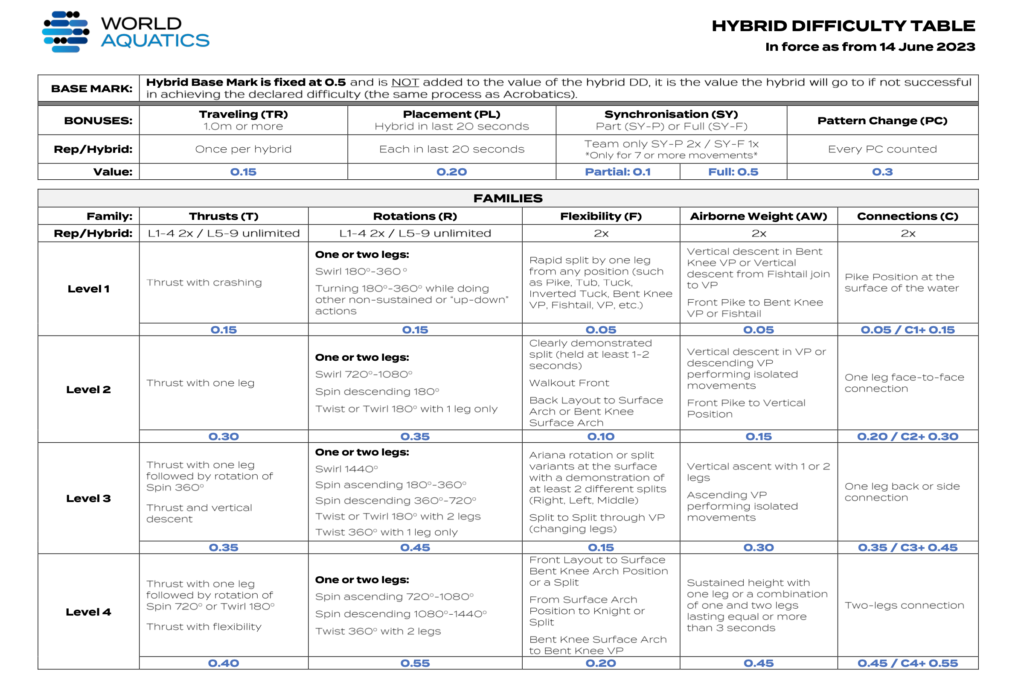World Aquatics has made changes to the the construction of the Degree of Difficulty (DD) for free hybrids in artistic swimming routines. In addition, the factors for each Element have been adjusted since the World Cup Super Final.
HYBRID DIFFICULTY TABLE
The meaning of Base Marks (BM) has drastically changed. The Base Mark is no longer the starting point and the base on what to construct the hybrid on, taking into account the number of movements and time spent underwater. It is now only the difficulty that remains when the declared movements don’t match the performed ones, just like in acrobatics.
Now, every free hybrid will have the same BM of 0.5. This new BM value is not added to the total DD of the hybrid. It is only the value that will be credited if the hybrid is not done as declared on the Coach Card.
To sum up, all free hybrids and team acrobatics have a BM of 0.5, and pair acrobatics have a BM of 0.1. Both BM values for the acrobatics have not changed from the previous regulations.
The other changes pertain to the bonuses. There are now only four bonuses. The Angles bonus has been entirely removed. Angles will be taken into account and judged by the artistic impression panel from now on.
The Pattern Change (PC) bonus has been modified. It was previously separated in two categories: PC-Simple (0.1) and PC-Complex (0.3). Every pattern change will now be worth 0.3. The number of PC per routine remains unlimited.
Of note, the number of repetitions per hybrid in the Rotations family, notably for the R5 – R9, remains unchanged as unlimited.
So, a free hybrid’s DD value is based on only two components from now on: Families of Movements and Bonuses. To obtain the final DD, one only needs to add up the numerical values of these two parts.
Consequently, it is now mathematically incorrect to compare scores and DD from any past competition from this season.
Here is the full Hybrid Difficulty Table in force as of June 14, 2023.
FACTORS
In this new scoring system, every Element score is factorized, as well as the Artistic Impression categories to try to balance everything out.
Weighing the different scoring categories is nothing new, and existed in the previous code of points. Obviously, it was a bit less complicated since we were working out of a 100 and not in an open-ended scoring system. If you recall, execution and difficulty were weighed at 30% each, while artistic impression was at 40%.
This season, the first three World Cups as well as most national championships around the world were held with an initial set of factors. However, new values were implemented during the World Cup Super Final in Oviedo to try to make artistic impression weigh a bit more in the balance, and to lower the influence of free hybrids on the total score.
This adjustment in factors explains why scores in Oviedo were overall lower from what was previously seen during the season, and why technical routine scores are now higher than free routine scores.
These new factors are expected to remain in place for the upcoming competitions.
Below are the factors as of the Super Final. In Artistic Impression, the categories for “performance” and “transition” remain factored at 1.0 throughout every routine, but the factor for “choreography and musicality” varies depending on the event.
For technical routines:
TRE: 0.8 (formerly 0.5)
Acrobatics: 0.7 (formerly 0.5)
Free Hybrids: 0.4 (formerly 1.0)
Choreo/Musicality: 1.8 (formerly 1.2 in solo and duet, and 1.8 in team)
For free routines:
Acrobatics: 0.5 (unchanged)
Free Hybrids: 0.5 (formerly 1.0)
Choreo/Musicality for solo, duet, and mixed duet: 1.4 (unchanged)
Choreo/Musicality for team: 2.4 (unchanged)
For acrobatic team:
Acrobatics: 0.8 (formerly 1.0)
Choreo/Musicality: 1.2 (unchanged)
Here is an example of a detailed scoresheet for a technical team routine:

The FC column designates the factors. Let’s have a look at the first Element, which is ACRO-B with a DD of 2.45. That’s multiplied by its factor of 0.7. So 2.45 x 0.7 = 1.715.
That is then multiplied by the average execution score. Here, after dropping the highest and lowest, the average is 9.00.
So 9.00 x 1.715 = 15.4350. That’s your total individual score for that Element. And so on!
In artistic impression, the factor for choreography and musicality is 1.8 in this case. This category isn’t based on average, but rather the sum of the three remaining execution scores after dropping the highest and lowest. So, 9.00 + 9.00 + 9.00 = 27.00.
That is multiplied by the factor of 1.8.
27.00 x 1.8 = 48.6000. This is your score for choreography and musicality.
The updated artistic swimming manual as well as other relevant documents can be found on World Aquatics. The updated difficulty guide has not yet been uploaded at the time of this writing.
The 2023 European Games will thus be the first competition with the new (new) rules.
ARTICLE BY CHRISTINA MARMET
Cover photo: Pasquale Mesiano / Deepbluemedia
If you’ve enjoyed our coverage, please consider donating to Inside Synchro! Any amount helps us run the site and travel costs to cover meets during the season.



